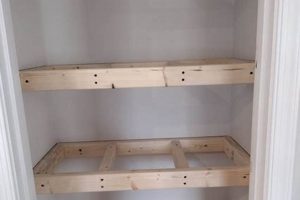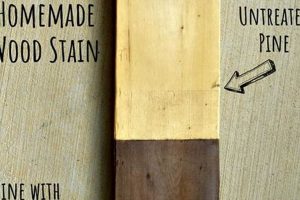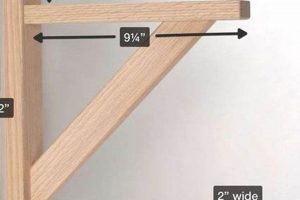The construction of backyard recreational equipment from lumber, undertaken by the homeowner, is a project with considerable appeal. These structures provide opportunities for outdoor activity and imaginative play for children. An example would be the assembly of a swing and slide apparatus using dimensional lumber and pre-fabricated components, following a set of instructions.
Creating such a structure offers numerous advantages, including cost savings compared to purchasing pre-assembled sets. Furthermore, it allows for customization to suit specific yard dimensions and children’s age ranges. Historically, families have engaged in similar projects, fostering a sense of accomplishment and contributing to a personalized outdoor environment.
The following sections will explore key aspects of this endeavor, including planning considerations, material selection, construction techniques, and safety protocols essential for ensuring a durable and secure playset.
Construction Insights
The successful creation of a backyard playset requires careful planning and precise execution. The following insights will guide the process, ensuring both structural integrity and user safety.
Tip 1: Comprehensive Planning: Prior to any construction, develop a detailed plan that outlines the dimensions, features, and overall design. Consider the available space, desired activities, and the ages of the children who will be using the apparatus. Detailed diagrams and material lists are essential components of this initial stage.
Tip 2: Material Selection: Opt for pressure-treated lumber specifically designed for outdoor use. Ensure the wood is free from knots, cracks, and other defects. Consider the use of naturally rot-resistant woods like cedar or redwood for elements exposed to direct contact with the ground.
Tip 3: Precise Cutting and Assembly: Accurate measurements and cuts are paramount. Employ power tools with appropriate safety precautions, and utilize a level to ensure structural components are plumb and square. Secure all connections with galvanized hardware resistant to corrosion.
Tip 4: Secure Anchoring: Properly anchoring the playset is crucial for stability. Depending on the soil conditions, consider using concrete footings, ground anchors, or other stabilization methods to prevent tipping or movement during use.
Tip 5: Surface Preparation: Sand all lumber surfaces to remove splinters and sharp edges. Apply a sealant or stain to protect the wood from the elements and extend its lifespan. Ensure all coatings are non-toxic and child-safe.
Tip 6: Safety Zone Establishment: Designate a safety zone around the entire structure, free from obstructions such as trees, fences, or other hazards. Consider installing a soft landing surface, such as mulch, rubber mats, or sand, to mitigate the risk of injury from falls.
Tip 7: Regular Maintenance: Implement a regular inspection schedule to identify and address any potential issues, such as loose hardware, damaged wood, or worn components. Prompt repairs will ensure the continued safety and longevity of the playset.
Adherence to these principles promotes a durable, safe, and enjoyable recreational structure. Careful attention to detail during construction mitigates potential hazards and maximizes the long-term value of the investment.
The concluding section will summarize the key considerations discussed and offer guidance on ongoing maintenance practices.
1. Precise Lumber Selection
The construction of a backyard recreational structure is fundamentally reliant on the selection of appropriate lumber. The material’s properties directly influence the playset’s structural integrity, safety, and lifespan. Inferior lumber, characterized by excessive knots, warping, or inadequate treatment, presents a significant risk of premature failure, potentially leading to injuries. For instance, using untreated pine in direct ground contact will result in rapid decay, compromising the support structure of swings or slides. Conversely, employing pressure-treated lumber designed for ground contact significantly extends the structure’s usable life and ensures its stability under load.
Different wood species and treatment levels offer varying degrees of resistance to decay, insect infestation, and environmental factors. For example, cedar exhibits natural resistance to rot, making it a suitable choice for components exposed to moisture, although it generally commands a higher price than treated pine. Pressure-treated lumber, identified by specific grades (e.g., ACQ, CA-B), undergoes a chemical process that infuses preservatives into the wood, rendering it resistant to degradation. The choice of lumber grade should align with the intended application, considering factors like ground contact, exposure to sunlight, and anticipated user weight. Proper selection necessitates a thorough understanding of wood properties and treatment standards.
In summation, precise lumber selection is not merely a superficial consideration, but a critical determinant of a backyard recreational structure’s safety and durability. Neglecting this aspect can lead to costly repairs, potential injuries, and a significantly reduced lifespan for the playset. The careful consideration of species, treatment, and grade is therefore paramount to the successful execution of the project and the safety of its users.
2. Rigorous Structural Design
The successful implementation of a backyard recreational structure, hinged on a do-it-yourself approach, mandates a foundation of rigorous structural design. The absence of such design precipitates compromised safety and diminished longevity. This design phase directly influences the load-bearing capabilities, stability, and overall resilience of the structure. A flawed design, neglecting factors like weight distribution or material stress, will result in potential failure points, creating hazardous conditions. For instance, a swing beam improperly sized relative to the anticipated load of multiple users will deflect excessively, potentially leading to breakage and subsequent injury. Consequently, prioritizing a robust and meticulously planned structural design is paramount to the safe and functional execution of the project.
Practical application involves a systematic approach to design calculations, material selection, and joint construction. Consideration must be given to local building codes and safety standards. Employing readily available design software or consulting with a structural engineer offers means to ensure the design adheres to accepted engineering principles. Critical elements include the determination of appropriate beam spans, post dimensions, and connection hardware. Furthermore, soil conditions and anticipated wind loads should be factored into the anchoring system’s design to prevent instability. The utilization of pre-engineered designs from reputable sources can provide a reliable starting point, but these must be carefully adapted to the specific site conditions and desired modifications.
In conclusion, rigorous structural design represents an indispensable element in the realm of backyard recreational structures. It addresses the potential for catastrophic failures inherent in improperly planned projects. Challenges lie in acquiring the necessary knowledge and skills to execute the design effectively. However, the benefits of a well-designed and constructed structure far outweigh the initial investment in time and expertise. It ensures a safe and enjoyable recreational experience for years to come, ultimately linking back to the core objective of fostering a secure environment for children’s play.
3. Secure Joint Construction
Within the context of constructing a backyard recreational structure from lumber, secure joint construction is not merely a desirable attribute but a fundamental necessity. The integrity of these connections directly dictates the structure’s capacity to withstand applied forces, ensuring the safety of its users. Inadequate joint construction represents a critical point of potential failure. The cause-and-effect relationship is unambiguous: improperly joined components weaken the overall structure, leading to instability or collapse under stress, such as the dynamic loads imposed by swinging or climbing. For instance, a swing set reliant on screws alone to join the swing beam to its support posts will almost certainly fail over time as the screws shear under repeated stress.
The importance of robust joinery is further underscored by the dynamic nature of the forces acting upon a playset. Children generate significant momentum while swinging, which translates into substantial shear and tensile stresses at the joints. Therefore, construction techniques must transcend simple fastening methods. Bolted connections, reinforced with washers and locknuts, offer enhanced resistance to these forces. Furthermore, incorporating gussets or bracing elements at critical junctions distributes the load more evenly, mitigating stress concentrations. Proper mortise and tenon joints, secured with adhesives and mechanical fasteners, can provide exceptional strength and stability. The choice of joinery method should be dictated by the specific load requirements of each connection point within the design. Failure to adhere to these principles can result in catastrophic structural failure, presenting a clear and present danger to the users.
In summary, secure joint construction constitutes a non-negotiable aspect of assembling a backyard recreational structure. The structural integrity and, consequently, the safety of the playset are inextricably linked to the quality and durability of its connections. Neglecting this facet of construction will invariably lead to compromised safety and a shortened lifespan for the structure. Prioritizing appropriate joinery techniques and employing robust hardware are therefore essential for responsible and reliable execution of the project.
4. Protective Surface Treatment
Protective surface treatment is inextricably linked to the longevity and safety of a wooden recreational structure. The primary function of such treatment is to mitigate the detrimental effects of environmental exposure, thereby preventing wood degradation and minimizing the risk of injury. The undertaking necessitates a proactive approach, beginning with the selection of appropriate products designed for outdoor use and extending to the meticulous application of these treatments according to manufacturer specifications. Failure to adequately protect the wood surface results in accelerated weathering, leading to cracking, splintering, and ultimately, structural weakening. A practical example is the application of a sealant or stain containing ultraviolet inhibitors, which shields the wood from sun damage, preventing premature fading and structural decay. This proactive measure significantly extends the lifespan of the structure, reducing the need for frequent repairs or replacements.
The selection of protective treatments must also consider the intended user demographic. Products should be non-toxic and free of volatile organic compounds (VOCs), minimizing potential health risks to children. Surface treatments also serve a crucial aesthetic purpose, enhancing the visual appeal of the structure and integrating it seamlessly into the surrounding landscape. For instance, a semi-transparent stain can accentuate the natural grain of the wood while simultaneously providing protection against moisture and insect damage. This dual functionality underscores the importance of carefully considering both the functional and aesthetic aspects of surface treatment. Regular inspection and reapplication of protective coatings are essential to maintain their effectiveness. Areas subject to high wear, such as swing seats and climbing surfaces, require more frequent attention to ensure continued protection against abrasion and moisture penetration.
In summary, protective surface treatment represents a critical component of a successful outdoor wooden recreational structure project. It is an investment in the structure’s longevity, safety, and aesthetic appeal. By selecting appropriate products and adhering to proper application techniques, it is possible to significantly extend the lifespan of the structure, ensuring years of safe and enjoyable use. The long-term benefits far outweigh the initial investment in time and materials, reinforcing the importance of prioritizing protective surface treatments in all phases of construction and maintenance.
5. Consistent Safety Inspection
The safe utilization of a recreational structure derived from a do-it-yourself lumber project is inextricably linked to the implementation of a consistent safety inspection protocol. The absence of routine inspection precipitates a heightened risk of undetected structural deficiencies, ultimately jeopardizing the well-being of users. A direct causal relationship exists: infrequent or nonexistent inspections permit minor issues, such as loose hardware or hairline fractures in wood, to escalate into major safety hazards. For instance, a swing set assembled from lumber may initially appear structurally sound, but repeated use and exposure to weather can loosen bolts securing the swing hangers. Without regular inspection, these loose bolts can progressively weaken the connection, potentially leading to a swing detaching during use, resulting in injury.
The importance of this inspection protocol extends beyond mere visual assessment. It necessitates a hands-on approach, involving the physical examination of all structural components, connections, and safety surfaces. Specific attention should be directed toward identifying signs of wood rot, insect infestation, or metal corrosion. Furthermore, the surrounding safety zone requires evaluation to ensure adequate clearance from obstructions and the maintenance of appropriate impact-absorbing materials. A practical example includes checking the depth of wood chips or rubber mulch beneath swings and slides, replenishing the material as needed to maintain adequate fall protection. Documentation of inspection findings and subsequent remedial actions provides a valuable record for tracking the structure’s condition over time, facilitating proactive maintenance strategies.
In conclusion, consistent safety inspection constitutes an indispensable component of responsibly managing a wooden recreational structure undertaken as a do-it-yourself lumber project. The proactive identification and mitigation of potential hazards, facilitated by routine inspection, directly contribute to the safety and longevity of the structure. While challenges may arise in consistently allocating time and resources for inspection activities, the potential consequences of neglecting this responsibility far outweigh the inconvenience. Emphasizing a culture of safety and vigilance ensures a secure and enjoyable recreational experience for all users.
Frequently Asked Questions
The following section addresses common inquiries regarding the construction of backyard recreational structures from lumber, emphasizing critical safety and structural considerations.
Question 1: What type of wood is most suitable for outdoor playset construction?
Pressure-treated lumber, specifically rated for ground contact, is recommended for structural components. Naturally rot-resistant species such as cedar or redwood can be utilized for aesthetic elements or where direct soil contact is unavoidable. Adherence to industry standards for wood preservation is paramount.
Question 2: How can structural integrity be ensured during the construction process?
Rigorous adherence to a well-vetted structural design, encompassing appropriate load calculations and material selection, is essential. Bolted connections with galvanized hardware should be prioritized over solely relying on screws. Consulting with a qualified engineer is advisable for complex designs.
Question 3: What safety precautions should be implemented during construction?
Utilizing appropriate personal protective equipment, including safety glasses and gloves, is mandatory. Power tools must be operated according to manufacturer guidelines. A designated safety zone around the construction area should be established to prevent accidental injuries.
Question 4: How frequently should the completed structure be inspected for safety?
A comprehensive safety inspection should be conducted at least twice annually, with increased frequency following periods of heavy use or inclement weather. Particular attention should be given to hardware connections, wood rot, and the integrity of safety surfacing.
Question 5: What type of surface treatment is recommended to protect the wood?
A non-toxic, exterior-grade sealant or stain containing ultraviolet inhibitors is recommended. The product should be specifically formulated for use on recreational equipment and applied according to the manufacturer’s instructions. Reapplication is necessary at intervals determined by environmental conditions and product specifications.
Question 6: Are there specific building codes or regulations that govern playset construction?
Local building codes and homeowner association regulations may impose specific requirements regarding playset construction, including setback distances from property lines and maximum height restrictions. Prior to commencing construction, it is incumbent upon the homeowner to verify compliance with all applicable regulations.
In summary, the construction of backyard recreational structures requires meticulous planning, adherence to safety protocols, and a commitment to ongoing maintenance. Neglecting any of these aspects can compromise the safety and longevity of the structure.
The following section will provide resources and references for further information.
Conclusion
The preceding exploration of constructing a backyard recreational structure from lumber has underscored critical considerations related to safety, structural integrity, and long-term durability. Aspects such as appropriate material selection, rigorous structural design, secure joint construction, protective surface treatments, and consistent safety inspections are paramount for responsible execution. The absence of diligence in any of these areas increases the potential for hazardous conditions and premature structural failure.
Given the inherent risks associated with elevated play structures, meticulous planning, adherence to established safety standards, and ongoing maintenance are non-negotiable. The commitment to these principles reflects a responsible approach to ensuring a safe and enjoyable recreational environment for children. Continued diligence and adherence to best practices remain essential for preserving the investment and safeguarding the well-being of its users.







